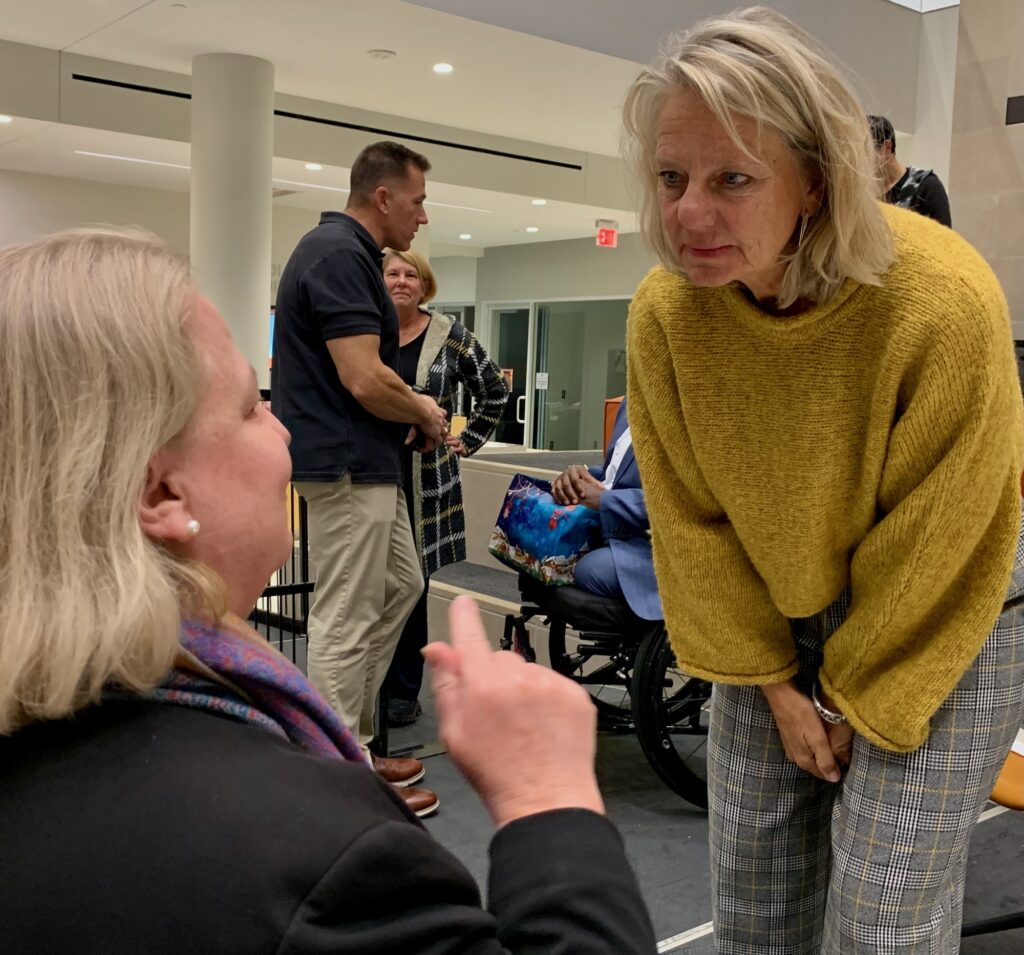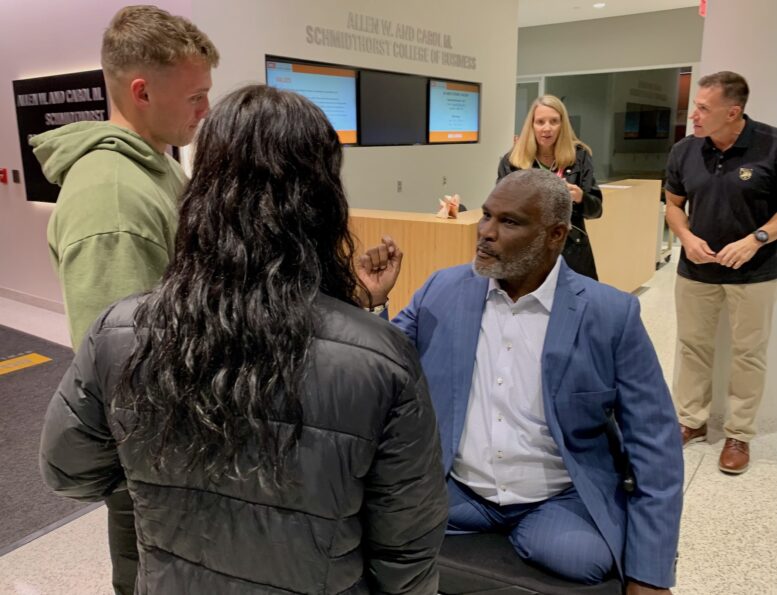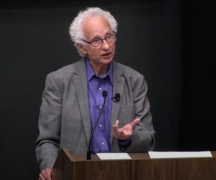By JULIE CARLE
BG Independent News
Bowling Green State University happened to be one of Retired Army Col. Greg Gadson’s waypoints on his life journey, even before he realized it.
His journey included four years at the United States Military Academy, where he played football; deployments in Iraq, Afghanistan and Bosnia; the loss of both legs after a life-altering Improvised Explosive Device (IED) attack in Iraq in 2007, and the painful recovery and rehabilitation that resulted in a man of deep faith, complete acceptance and total gratitude.
Gadson was on BGSU’s campus Thursday with co-author Terese Schlachter, a 1985 BGSU radio-TV-film graduate. Together they were responsible for telling his story in the book “Finding Waypoints: A Warrior’s Journey Towards Peace and Purpose” and in front of the Bowling Green audience.
They met four months after the blast that lifted his 15,00-pound armored vehicle off the road, ejected him out of the vehicle and nearly killed the battalion commander in Iraq. He was in the then-new rehabilitation wing at Walter Reed Army Medical Center, and Schlachter was covering her first story for what was known as the Pentagon Channel, after working in various television markets for 20 years.
When she met him, Gadson was learning to use his prosthetic legs. He wore a harness and was attached to a ceiling track to keep him safe if he fell.
“The photographer is with me and he’s rolling as Greg comes clumping by, and he wiped out right in front of me and the camera,” Schlachter said. “He looked up at me and said, ‘Are you going to use that?’ I said, ‘Yes.’”
He was a little frustrated, but he gathered himself together and said he would have to do it again. That sense of determination and pushing through the hard parts was the whole point of the story that day, she told him.
“I would say, Greg literally fell into my life, and it was never the same,” Schlachter said.
Gadson had never intended to be a soldier. He had trained hard in high school with a goal to play Division I football in college and then be a professional football player. When a football scholarship fell through, he was fortunate to meet a football recruiter from West Point.
“I had no idea what it was. The only question I asked when I visited was if they played Division I football. They said ‘Yes,” and I said ‘I’m in.’”
He had a five-year service obligation after graduating from the academy, but he thought he would honor his five years and then move on to the civilian world. But he “fell in love with being a soldier, the team aspect, and being part of something bigger than myself,” Gadson said.
Still uncertain if he would be career-military, he decided to take it one year at a time. “When I got to about year 13, I said I was going to do 20 and no more,” he said.
The accident occurred in year 17. And if not for the valor of the men and women that he was responsible for training, he would not have lived.
Four days after the blast, he was at Walter Reed where they had to amputate one of his legs and eventually the second one. “And so began a new chapter or phase in my life,” Gadson said.
There have been many waypoints or guideposts along his path of recovery and acceptance. He never would have believed his West Point connections would have been critical to his recovery. And yet, they were.
There was a long line of people who stepped up and supported Gadson throughout and after his rehabilitation. Many of them were West Point classmates or graduates from before or after his time at the academy.
The doctor who operated on Gadson the first night was a 1991 West Point graduate who only knew him as a former cadet football player. The doctor made the decision that night to use 129 pints of blood and empty out the blood reserves to save Gadson’s life.
Dr. Paul Pasquina, Gadson’s physical and rehabilitation doctor at Walter Reed, was another teammate two years ahead of him. And the first person to hear him speak when he came out of his coma was Chuck Schretzman, a classmate, teammate and best man at his wedding.
“It was overwhelming just to think about that sort of path that you live, and you don’t understand and appreciate the impact that you had on people until this moment,” he said. “They were the underwriters of my recovery–this amazing network of friendships and love beyond anything that I could have ever imagined.”
The obscure BGSU waypoint
Three of Gadson’s football coaches played a significant role in his life and recovery. Head Army Coach James Young wrote a letter that Schretzman was reading to Gadson when he came out of his coma.
Young and Army tight end coach Jack Hecker were classmates and teammates at Bowling Green State University. Gadson’s position coach at the academy was Tim Kish, who completed his graduate degree at BGSU.

When Gadson learned that Schlachter, a BGSU alumna who had become a good friend, wanted to write his life story, the connection was too serendipitous to ignore. “Was it a miracle, a coincidence, or is it really about the quality of folks when our orbits do cross?” he said. “That’s really what I believe.”
A long process
He wasn’t keen on the idea of a book about his story. It felt too personal and too public, he said. Eventually Schlachter convinced him (with some push from Schretzman) that the book “was about helping other people,” he said. “I understood that. It’s part of my DNA, I think that is part of who I am.”
Though he had been open about his life and talking about it, a book took the story in a different direction. He was no longer in control of the story, he thought. “Now, it was for the world to see anytime they wanted to pick it up, and that was scary.”
He knew the story was special. “And I couldn’t let something that she did, she poured her heart into just sit there,” he admitted.
The book process took 16 years from start to finish, Schlachter said.
There were lots of starts and stops, revisions and new information to include in the book that she learned about, not from Gadson but from his buddy Schretzman. Like when she learned he had been a motivational speaker for the New York Giants team, the year they were in last place but went on to win the Super Bowl against the New England Patriots in 2012. Or that he made his acting debut in “Battleship,” a 2012 American science fiction naval war film.
There was also a lapse of 13 years before Gadson would even read what Schlachter had written because “There was just too much emotion,” he said.
Schlachter read the first chapter to him over Zoom during the pandemic, and his perspective started to change. Actually, over the 16 years of the process his perspective changed in many ways, she said.
“You learned so much about yourself, about recovery and you gained so much perspective that it became a much better book over that time,” she said.
A light-bulb moment for Gadson came from a conversation with Retired U.S. Army Lieutenant General Patricia Horoho, who serves on the Gary Sinise Foundation with him. “
We were talking about the book, and I was telling her about my struggles with it coming out,” he said. She responded that the book was part of his healing.
“It was part of my journey and another waypoint,” he admitted.
“I don’t know if we ever truly heal. Sometimes we learn to live with loss and sacrifice,” he said.
Loss of this magnitude “takes a part of your soul that you can never get back,” he said. “But this book has restored a part of me and I‘m super proud of Terese.”
One of the most significant waypoints for Gadson, and the reason he has no desire for retribution against the perpetrator of the blast is the power of accepting what happened to him through his faith.
“From a medical perspective, I’m not supposed to survive that. When I was blown out of that vehicle and realized I was going to die, I prayed to God and said, ‘God I do not want to die here.’ Gadson said. “I say, God not only saved me, but he also healed me.”
Gadson has no anger or hate in his heart. Three weeks after the accident he was on the path to healing because he was “unencumbered by that anger and hate,” he said. “God lifted that from my heart. I was free of it and able to move forward.”
The Wood County District Public Library has 10 copies of the book to borrow, and information about the book and how to order it is on the publisher’s website at schaffnerpress.com/books/finding-waypoints/.





